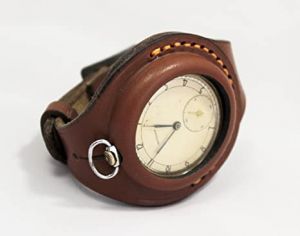Difference between revisions of "Watch Straps"
(→Perlon) |
(→Rubber) |
||
| Line 29: | Line 29: | ||
A synthetic leather made by DuPont in the 1960s. [[Corfam|You can read more about Corfam here]]. | A synthetic leather made by DuPont in the 1960s. [[Corfam|You can read more about Corfam here]]. | ||
===Rubber=== | ===Rubber=== | ||
| + | Vulcanized rubber was a natural choice for watch manufacturers . It has excellent strength and resilience and easily returns to its original intended shape after bending. It resists wear and tear and oxidation. It repels fats, oils and other solvents, while also limiting water absorption. It has a wide temperature range making it flexible and reliable between −80 °C to +250 °C and won’t break down until it hits temperatures above 350 °C. | ||
| + | |||
| + | The watchmaking industry first began adding rubber bands to their timepieces in the 1950’s. [[Rolex]], [[Tudor]], [[IWC]] and [[Blancpain]] were some of the early timepieces found with rubber bracelets. However, it wasn’t until the 1960’s that the use of rubber bands became mainstream, largely due to its usefulness on diver and sports watches. | ||
| + | |||
===Plastic=== | ===Plastic=== | ||
===Cloth=== | ===Cloth=== | ||
Revision as of 17:23, 10 February 2021
Watch Straps
There as many types of straps as there are watches...and that is a lot! It is proposed here to outline the types of straps and materials used, as well as pointing collectors in the direction for the correct one for their prized possession.
Watch Strap Terminology
Straps
- Width - how wide the strap is, in order for it to fit between the case lugs. Normally in millimeters now, but up to the 1980s it is also seen in imperial inches. Common sizes are 16mm. 18mm. 20mm and 22mm.
- Length - how long both parts of the strap are, normally measured in millimeters, eg 115/75. The can be found is short, medium and long which normally accomodates a 6.5 to 8 inch wrist (
- Taper - how narrow the end of the strap is at the buckle compared to the lug width eg 18/14, 20/16 or in modern cases no taper eg 20/20. Older straps had much more pronounced tapers with smaller buckles
- Keeper - the small retaining loop in which the end of the strap can be tucked to stop it flapping loose. Can be fixed, eg attached to the strap, or floating eg free to move.
Buckle
Buckles are mainly made from high quality steel, but they can be 18k gold, silver, platinum, plated, chromed and just about anything else you can imagine.
- Tang-type buckle: By far the most common. Operates just like most men's belts. 3 parts with a buckle, tang and pin.
- Deployant clasp, inside style: On this style, the 'tail' of the watch strap goes on the inside of the clasp. While this style has a more elegant look, it does not always work with just any standard strap. Often, a custom strap is needed to prevent the tang-slot and keeper loop features of the strap from showing.
- Deployant clasp, outside style: With this second type, the tail of the strap goes on the outside--the same way it does with a standard tang-type buckle. This is the more common type and several versions are available that can fit on to most existing leather watch straps.
Strap Materials
Leather
The earliest wristwatches used leather, and it is still a favourite choice, from high end dress watches to everyday 'beaters'. Styles go in and out of fashion but there are some classics that remain constant. The straps first worn by men, during battles, were of a broad rubust nature, often extending beyond and behind the watch in order to protect it. These 'bund' style straps are still used with larger watches and ones with military association.
Nylon
Perlon
A nylon-weave single pull through Zulu-style with single floating keeper. Technically a type of nylon produced by the polymerization of caprolactam. The advantage of Perlon straps is that they have no fixed hole location. The tang of the buckle will push through at any point of the weave, thus making a perfect fit every time. They were initally used and found in military applications but are now appeal to a wider audience. Their construction makes them waterproof, fade-proof and very durable, which is an attraction to those diving. Skin diver watches look particularly good on these.
Corfam
A synthetic leather made by DuPont in the 1960s. You can read more about Corfam here.
Rubber
Vulcanized rubber was a natural choice for watch manufacturers . It has excellent strength and resilience and easily returns to its original intended shape after bending. It resists wear and tear and oxidation. It repels fats, oils and other solvents, while also limiting water absorption. It has a wide temperature range making it flexible and reliable between −80 °C to +250 °C and won’t break down until it hits temperatures above 350 °C.
The watchmaking industry first began adding rubber bands to their timepieces in the 1950’s. Rolex, Tudor, IWC and Blancpain were some of the early timepieces found with rubber bracelets. However, it wasn’t until the 1960’s that the use of rubber bands became mainstream, largely due to its usefulness on diver and sports watches.
